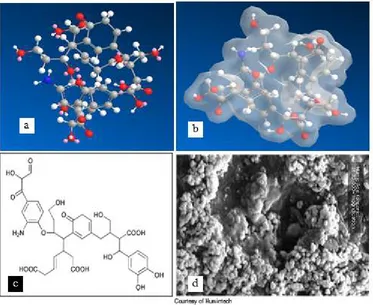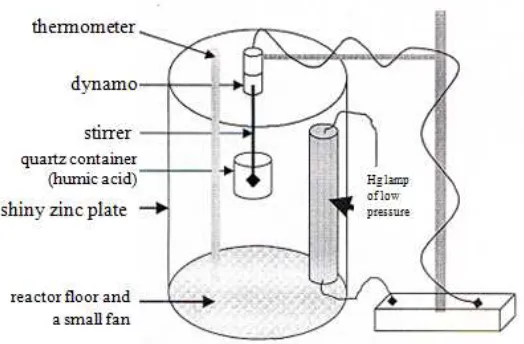Der Pharmacia Lettre, 2016, 8 (15):120-124 (http://scholarsresearchlibrary.com/archive.html)
ISSN 0975-5071 USA CODEN: DPLEB4
Effect of Temperature and Particle Motion against the ability of ZnO
Semiconductor Photocatalyst in Humic Acid
Rahadian Zainul
Department of Physical Chemistry, Universitas Negeri Padang, Air Tawar, Indonesia
_____________________________________________________________________________________________
ABSTRACT
It has been studied to determine the effect of temperature and particles motion of zinc oxide semiconductor from commercial ZnO powder on phototransformation of humic acid, using B & L 20 Spectronics. This study was done under some optimum conditions: lighting time of 2 hours, using Hg lamp of low pressure (λ = 254 nm), humic acid of 100 ppm and pH=9.2. it was disclosed that 97.51 % of humic acid transformed into minerals product. This research can contributed to solve the environmental problems in peat water.
Keywords: Photocatalyst, Zinc Oxide, Temperature, Particle Motion, Humic Acid
_____________________________________________________________________________________________
INTRODUCTION
Semiconductor applications widely known, both to obtain energy from indoor lights using oxide cuprum[1], photo-splitting water for hydrogen production[2] until the compound photo-transformation. All of these for overcoming the problem of the industry and the environment is a very interesting study. Various types of compounds [primarily organic compounds] contaminants that have been successfully transformed with these methods, among others, alkanes, aliphatic alcohols, aliphatic carboxylic acids, alkenes, phenolic compounds, aromatic carboxylic acids, dyes. Simple aromatic compounds, halogenated alkanes and alkenes, surfactants and pesticides[3].
Semiconductor zinc oxide [ZnO] is an alternative option after the semiconductor TiO2 in its application as a
photocatalyst. As a basic consideration is the semiconductor ZnO resistant to corrosion, has a relatively low light energy [Eg = 3.40 eV], and is much cheaper than TiO2[3]. Research photocatalyst ZnO has been made include
studies in nano material in the form of suspension of nano-ZnO[4], nanowire ZnO[5], a thin film of ZnO[6], nanocrystalline ZnO[7], nano fiber ZnO [8], and several nano composite ZnO, such as Au-ZnO[9], FGS/ZnO[10], ZnO/CuO[11], ZnO-TiO2[12]. In this research, ZnO used is a commercial ZnO powder, because of economic
considerations for direct application on water purification peat containing humic acid, fulvic acid and humin.
______________________________________________________________________________
Figure 1. Humic Acid (HA) modeling (a) 3D Steeling model by ChemBio3D computerizing with software Cambridgesoft Ultra 11.0 (b) modeling surface HA of Connoly Molecular with Tranclucent display mode, (c) Humic Acid monomer structure according Steelink
Model(13) and (d) SEM image of supramolecular humic acid with 35,000 x magnification (Humintech)
MATERIALS AND METHODS
Samples are peat water that was in the location of PT Mutiara Agam, Tiku, Pariaman. The tools used are Spectronic 20 B & L, balance of electric fan, mercury-vapor lamp low pressure (λ = 254 nm), oven Gallenkamp, burette 25 mL, stopwatch, centrifuges, shakers, stirrers automatically, thermometer, desiccator, tube lighting, tweezers, glass plates, an electric cooker and tools commonly used glassware.
Materials used in the form of commercial ZnO powder, concentrated sulfuric acid, uranyl acetate 0:02 M, oxalic acid 12:02 M, potassium permanganate 0:02 M, HCL 0.1N NaOH 0.2 N, NaCl, fenolptalein, ethyl acetate, hexane, methanol, plate TLC and distilled water
Isolation Humic Acid
Humic Acid will be isolated by simple method. Into a glass beaker with a capacity of 30± L filled 25 L of water peat 0.1 N HCl is added until a pH less than 2. After settling for 4 days, the precipitate separated by centrifuge. The precipitate was washed with 95% alcohol and then dried in the desiccator. Structure of Humic Acid can be modeled and showed in figure 1.
Identification and Purification Humic Acid
To test whether the isolated form brownish powder is humic acid or not done tests with a solution of NaCl. When the positive test solution precipitates a brown and grayish. Humic acid purification is done by washing the blackish brown powder with 95% alcohol many times until got 2 staining on Thin Layer Chromatography (TLC).
Determination of Effective Condition
Determination of the effective conditions include determining the distance of irradiation effectively done actinometry of uranyl oxalate, determining the effective concentration of ZnO, the determination of the effective exposure time and the determination of the effective pH.
Activity Test of ZnO Semiconductor Photocatalyst
hour irradiation.
RESULTS AND DISCUSSION
Activitiy Test of ZnO Photocatalyst
Activity test of photo-transformation will under due in reactor as showed in figure 2. By using all effective conditions (distance irradiation, ZnO concentration, exposure time and pH), then tested the activity of ZnO semiconductor photocatalysts that the data and results of calculations percent of its transformation can be seen in table 1 and figure 3. It can be observed that in 2 hours irradiation using light low-pressure, (λ=254 nm) to 20 mL of 100 ppm of humic acid at pH 9.2, was 97.51% humic acid can be transformed with 10 mg ZnO semiconductor photocatalysts. With the four treatment (treatment 2, 3, 4 and 5) the prediction of the effects of temperature, and the stirring of the photocatalyst photo-transformation process of humic acid.
Figure 2. Schematic Photo-reactor for transformation humic acid
Modification of semiconductors by changing the environmental conditions found that at pH 12, Eg (gap energy) inexplicable existence. This is due to undergo dissolution to form ZnO, Zn(OH)2 due to adsorb OH group
(hydroxyl). This is due to an increase in catalytic activity due to increases in semiconductor ZnO valence band energy greater than the increase of energy in the conduction band. Such changes would reduce the energy gap (Eg) between PV and PK so that more electrons can be excited. At pH 3, two-thirds of PV energy rose while PK rose only one-third that Eg is reduced [14].
Oxygen plays an important role in the ZnO semiconductor photocatalysts (including TiO2), then process involving
contaminants photo-transformation semiconductor photocatalyst, light (can be used indoor lights) and oxygen can produce products that are environmentally friendly [15].
Table 1. Percent transformation upon irradiation of 100 ppm humic acid at pH 9.2
NO TREATMENT Percent Tranformation (λ=730nm) Percent Transformation (λ=340 nm, control)
1 ZnO + AH + h(Stirred) ν 97,51 98,67
2 ZnO + AH (Dark)
(Stirred) 1,33 2,04
3 ZnO + AH (54
oC)
(stirred) 5,38 5,43
4 ZnO + AH (indoor lights)
(Stirred) 2,67 3,21
5 ZnO + AH + hν
(No Stirring) 42,31 43,42
6 AH + hν
(Stirred) 26,00 27,62
HA : Humic Acid 100 ppm pH 9,2
hv : photon from of low-pressure mercury vapor lamp (λ = 254 nm) 2-5 : with treatment
______________________________________________________________________________
.
Figure 3. : Activity Test of Photocatalyst Semiconductor ZnO in various treatment
Effect of Temperature
As revealed by Cotton et al (1995) and Sharpe (1992) that the temperature is one of the drivers for the formation of the couple charged (h+pv/e-pk) which are vital to the working of semiconductor photocatalysts [16; 17]. The theory
could explain why the treatment 2 (average temperature) 29oC there is still showing a ZnO semiconductor photocatalyst performance of 1.33% and increased in 3 treatments (average temperature of 34oC = average temperature of treatment 1) to 5.38%.
It can be observed that the result of joint work between ZnO semiconductor photocatalyst, irradiation and temperature above the Fermi level (0 K) gives the photocatalyst performance 97.51% humic acid within 2 hours. However, when compared with the treatment of temperature with radiation treatment plus a photocatalyst, the effect of irradiation plus photocatalyst (97.51% - 5.38% = 92.13%) is still much greater than the effect of temperature (34oC) plus a photocatalyst (5.38 %).
Effect of Particles Motion
Actually, the process of transformation photo humic acid is a joint work between the photocatalyst, temperature, radiation, and stirring. Although, only a photocatalyst working alone or working radiation alone. There is interplay between the events of the photocatalyst, temperature, and radiation are mutually continuous in catalyzing the photo-transformation humic acid. However, the greatest influence is still given by the cooperation between the photocatalyst by irradiation.
When compared with the control treatment 1 and 6, it is evident that the presence of ZnO semiconductor photocatalysts, the process of photo-transformation lasts more powerful (97.51%). While the absence of ZnO process only efficiency transformation of 26.00%. So the ZnO semiconductor photocatalyst help the photo-transformation process of humic acid by 71.51% (derived from the difference between 97.51% - 26.00%). The results of this study further support for what has been done Requel and Nogueira (1993), which compares labor semiconductor photocatalyst with two controls [18]. They obtained the fact that with the cooperation between the semiconductor and the radiation is able to transform 99% of methylene blue compared to 15% who did not wear a semiconductor.
Effect of Stirring
With the stirring, the process of transformation lasts photos faster. The results of this study prove that treatment 1 (no stirring) gives percent larger transformation that is 97.51% compared 5 treatment (without stirring) is only 41.31%
O2 + H → HO2 *HO
2- + h+ PV→*HO2
2 *HO2 → O2 + H2O2
H2O2 + *O2-→ *HO + OH- + O2
Highly reactive hydroxyl radicals will attack the substrate (in this case is the humic acid molecules). Furthermore, there will be a chain reaction that resulted transformation of humic acid.
The hydroxyl radical as the most important species to trigger the process is highly dependent photo-transformation amount of oxygen involved in the reaction. When oxygen levels are high then the more hydroxyl radicals are formed. Unsurprisingly, a process that uses oxygen dissolution stirring helps to have a higher performance than the process without stirring in a reaction semiconductor photocatalyst.
Another function is to flatten stirring so that the entire suspension portion exposed beams and enhance interaction between ZnO semiconductor photocatalyst molecules of humic acid. Further stirring can balance the adsorption-desorption processes on the surface of a semiconductor, because if the process is not balanced (higher than the adsorption desorption) then by Hoffman et al. (1995) substrate entry process will then be blocked. As a result, the efficiency will be lower semiconductor photocatalysts [3].
CONCLUSION
Based on the research process of photo-transformation 20 mL of 100 ppm of humic acid at pH 9.2 under irradiation mercury low pressure lamps (λ = 254 nm) and with the help of 10 mg ZnO capable of transforming a 97.51% humic acid within 2 hours. Stirring helps the process of transformation of humic acid catalyzed by ZnO semiconductors amounted to 55.2%
REFERENCES
[1]Zainul R, Alif A, Aziz H, Arief S, Dradjad S, Munaf E. 2015. Research Journal of Pharmaceutical, Biological
and Chemical Sciences 6(4):353-61
[2]Zainul R, Alif A, Aziz H, Yasthopi A, Arief S, Syukri. 2015. Journal of Chemical and Pharmaceutical Research 7(11):57-67
[3]Hoffman MR, Martin ST, Choi W, Bahnemann DW. 1995. Chem. Rev. 95 71-4, 7, 9, 82, 5-7
[4]Habib MA, Muslim M, Shahadat MT, Islam MN, Ismail IMI, et al. 2013. Journal of Nanostructure in Chemistry 3:70
[5]Iqbal J, Jan T, Ronghai Y, Naqvi SH, Ahmad I. 2014. Nano Micro Letters 6:242-51 [6]Chen R, Han J, Yan X, Zou C, Bian J, et al. 2011. Appl Nanosci 1:37-44
[7]Ahmed MNZ, Chandrasekhar KB, Jahagirdar AA, Nagabhushana H, Nagabhushana BM. 2015. Appl Nanosci DOI 10.1007/s13204-014-0395-1
[8]Mauro AD, Zimbone M, Scuderi M, Nicotra G, Fragala ME, Impellizzeri G. 2015. Nanoscale Research Letters 10:484
[9]Ranasingha OK, Wang C, Jr. PRO, Lekse JW, Lewis JP, Matranga C. 2015. Journal of Material Chemistry A [10]Yang Y, Ren L, Zhang C, Huang S, Liu T. 2011. ACS Applied Materials and Interfaces 3:2779-85
[11]Chang T, Li Z, Yun G, Jia Y, Yang H. 2013. Nano Micro Letters 5:163-8
[12]Habib MA, Shahadat MT, Bahadur NM, Ismail IM, Mahmood AJ. 2013. International Nano Letters 3:1-8 [13]Wandruszka Rv. 2000. Gheochem. Trans 2
[14]Erright B, Firtzmaurice D. 1996. J. Phys. Chem 100:1033 [15]Mao Y, A. B. 1996. J. Phys. Chem. 100:4219
[16]Cotton. A. 1995. Basic Inorganic Chemistry Jon Wiley and Sons
[17]Sharpe G. 1992. Inorganic Chemistry, Third edition, John Willey and Sons:160 [18]Raquel FP, Noqueira R. 1993. J. Phys. Educ. 70:861-2

